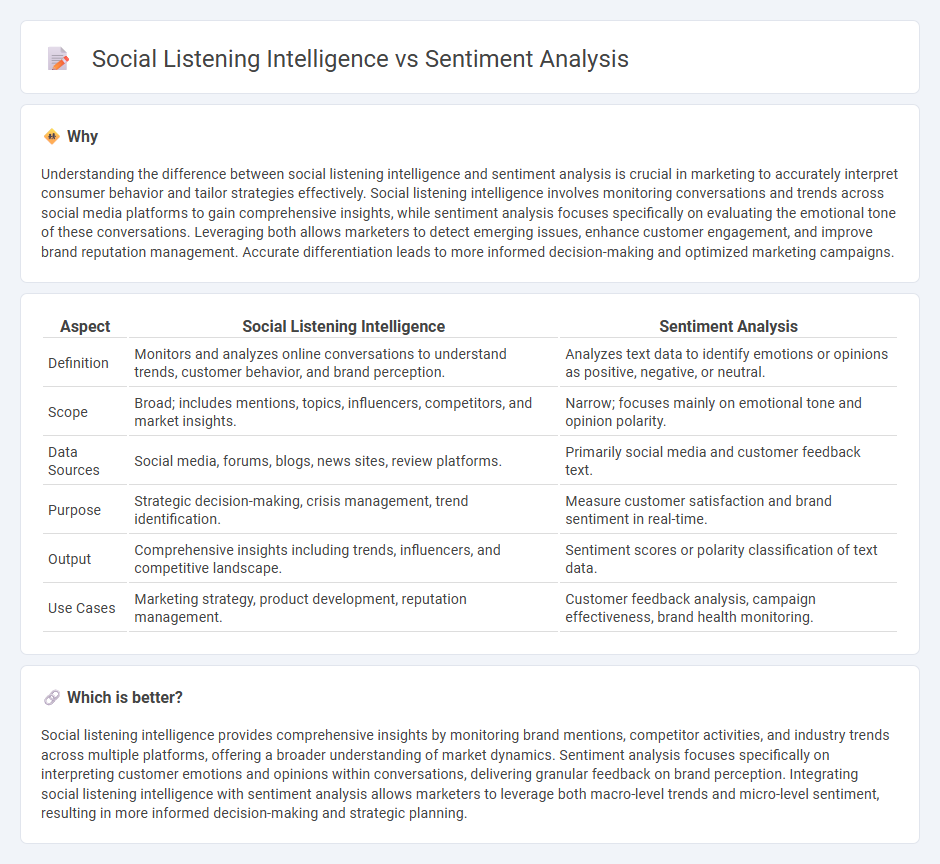
Social listening intelligence captures real-time conversations across social media platforms to identify emerging trends and customer opinions, providing a comprehensive understanding of brand perception. Sentiment analysis uses natural language processing algorithms to classify the emotional tone behind user-generated content, measuring positive, negative, or neutral attitudes toward products or services. Explore the distinct advantages of social listening and sentiment analysis to elevate your marketing strategy.
Why it is important
Understanding the difference between social listening intelligence and sentiment analysis is crucial in marketing to accurately interpret consumer behavior and tailor strategies effectively. Social listening intelligence involves monitoring conversations and trends across social media platforms to gain comprehensive insights, while sentiment analysis focuses specifically on evaluating the emotional tone of these conversations. Leveraging both allows marketers to detect emerging issues, enhance customer engagement, and improve brand reputation management. Accurate differentiation leads to more informed decision-making and optimized marketing campaigns.
Comparison Table
| Aspect | Social Listening Intelligence | Sentiment Analysis |
|---|---|---|
| Definition | Monitors and analyzes online conversations to understand trends, customer behavior, and brand perception. | Analyzes text data to identify emotions or opinions as positive, negative, or neutral. |
| Scope | Broad; includes mentions, topics, influencers, competitors, and market insights. | Narrow; focuses mainly on emotional tone and opinion polarity. |
| Data Sources | Social media, forums, blogs, news sites, review platforms. | Primarily social media and customer feedback text. |
| Purpose | Strategic decision-making, crisis management, trend identification. | Measure customer satisfaction and brand sentiment in real-time. |
| Output | Comprehensive insights including trends, influencers, and competitive landscape. | Sentiment scores or polarity classification of text data. |
| Use Cases | Marketing strategy, product development, reputation management. | Customer feedback analysis, campaign effectiveness, brand health monitoring. |
Which is better?
Social listening intelligence provides comprehensive insights by monitoring brand mentions, competitor activities, and industry trends across multiple platforms, offering a broader understanding of market dynamics. Sentiment analysis focuses specifically on interpreting customer emotions and opinions within conversations, delivering granular feedback on brand perception. Integrating social listening intelligence with sentiment analysis allows marketers to leverage both macro-level trends and micro-level sentiment, resulting in more informed decision-making and strategic planning.
Connection
Social listening intelligence collects data from online conversations to track brand mentions and customer opinions, providing a rich source of real-time market insights. Sentiment analysis processes this data using natural language processing to categorize emotions behind customer feedback as positive, negative, or neutral. Together, these tools enable marketers to gauge public perception accurately, tailor campaigns effectively, and respond promptly to consumer needs.
Key Terms
**Sentiment Analysis:**
Sentiment analysis uses natural language processing and machine learning algorithms to identify and quantify emotions in text data, providing insights into customer opinions and brand perception. It processes vast amounts of social media posts, reviews, and comments to detect positive, negative, or neutral sentiments with high accuracy. Explore how advanced sentiment analysis techniques can enhance your understanding of audience attitudes and improve strategic decisions.
Polarity
Sentiment analysis quantifies polarity by classifying text as positive, negative, or neutral, providing a straightforward metric for emotional tone in customer feedback. Social listening intelligence expands on this by contextualizing polarity within broader conversations, tracking shifts in public opinion across platforms and identifying emerging trends. Explore more to understand how combining these tools enhances brand strategy and customer insights.
Natural Language Processing (NLP)
Sentiment analysis uses Natural Language Processing (NLP) to categorize text data by emotional tone, identifying positive, negative, or neutral sentiments in customer feedback, reviews, or social media posts. Social listening intelligence extends this by monitoring real-time conversations across multiple channels, leveraging NLP to capture context, trends, and emerging topics for deeper brand reputation and market insight. Explore how combining NLP-driven sentiment analysis and social listening intelligence can elevate your strategic decision-making.
Source and External Links
Sentiment Analysis and How to Leverage It - Qualtrics - Sentiment analysis interprets qualitative data to understand people's feelings toward topics, products, or experiences, with common types including fine-grained, aspect-based, and intent-based sentiment analysis.
What is Sentiment Analysis? | Definition from TechTarget - Sentiment analysis, or opinion mining, uses NLP, AI, and machine learning to identify emotional tone in texts to help organizations understand opinions about products or services.
What is Sentiment Analysis? - AWS - Sentiment analysis classifies digital text by emotional tone--positive, negative, neutral--and includes types like fine-grained scoring, aspect-based, intent-based, and emotional detection analysis for deeper psychological state interpretation.
 dowidth.com
dowidth.com